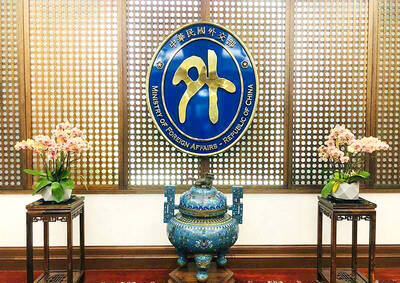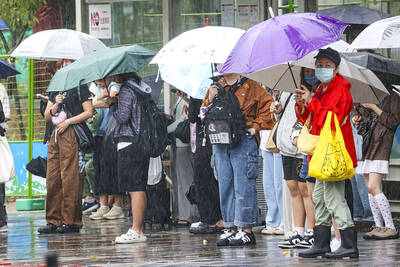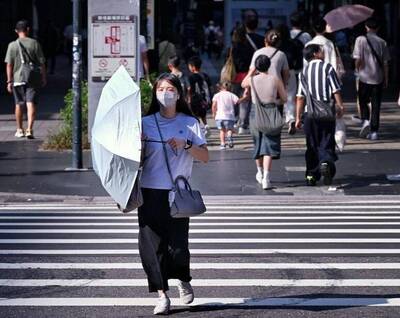A large waist circumference can lead to increased risk of cardiovascular diseases, but a survey showed that up to 46.8 percent of respondents had not measured their waist in the past year, the Taiwan Millennium Health Foundation said on Monday as it announced the launch of its annual waist measurement health awareness campaign.
The foundation and the Health Promotion Administration hold “89 Waist Measurement Day” on or around Aug. 9, with the month and date numbers to remind people to keep a healthy waist size — below 80cm for women and below 90cm for men.
Foundation chairman Wayne Sheu (許惠恒) said this year is the 16th campaign since it was launched in 2006.

Photo: Chiu Chih-jou, Taipei Times
About 70 percent of people are aware of the “80cm and 90cm” healthy waistline standard, but 46.8 percent did not measure their waist in the past year, Sheu said, citing a foundation survey.
Given the results, the foundation collaborated with the National Health Insurance Administration (NHIA), adding a new feature to its NHI Express App that reminds people to keep a log of their waist measurements.
NHIA Director-General Lee Po-chang (李伯璋) said the “three highs” — high blood pressure, high blood lipids and high blood sugar — are common health issues among adults, so the NHIA in June launched a metabolic syndrome prevention program.
As the NHI Express App has been downloaded more than 20 million times, the NHIA hopes it will become a “health passbook,” Lee said.
HPA Deputy Director Wei Shi-lun (魏璽倫) said that among the approximately 1.9 million people who in 2020 underwent the government-funded adult preventive health examination for adults aged 40 or older, more than 60 percent had a waist circumference exceeding 80cm or 90cm and metabolic syndrome.
Chan Ding-cheng (詹鼎正), director of National Taiwan University Hospital’s Department of Geriatrics and Gerontology, said that the diagnosis of metabolic syndrome is made when a person meets three of five criteria: a large waist circumference; blood pressure of 130/85 millimeters of mercury or higher; a fasting blood glucose level of 100 milligrams per deciliter (mg/dL) or more, or the person is taking glucose-lowering medication; a triglyceride level of 150mg/dL or more; and a high-density lipoprotein level less than 40mg/dL for men or less than 50mg/dL for women.
A large waist circumference suggests an excess of abdominal visceral fat, which can lead to increased risk of cancer, dementia and cardiovascular diseases, Chan said.
Studies suggest that the risk of developing cardiovascular disease increases by 2 percent for each 1cm of waist circumference, while the risk of death is increased by 17 percent in men and by 13 percent in women for each 5cm, he said.
People with a healthy waist circumference should measure it at least once per year, while those with a large waist circumference should do so every week, he said, adding that the records can be kept using the NHI Express App.
The foundation in cooperation with Uni-President Group has a program to distribute free measuring tapes at more than 1,300 locations of the corporation’s 16 distribution channels, including 7-Eleven convenience stores, Starbucks coffee shops and Carrefour supermarkets.
People can enter a lottery on the foundation’s Web site to win cash certificates by logging their waist circumference on NHI Express App before Sunday next week.

Temperatures in northern Taiwan are forecast to reach as high as 30°C today, as an ongoing northeasterly seasonal wind system weakens, the Central Weather Administration (CWA) said. CWA forecaster Tseng Chao-cheng (曾昭誠) said yesterday that with the seasonal wind system weakening, warmer easterly winds would boost the temperature today. Daytime temperatures in northern Taiwan and Yilan County are expected to range from 28°C to 30°C today, up about 3°C from yesterday, Tseng said. According to the CWA, temperature highs in central and southern Taiwan could stay stable. However, the weather is expected to turn cooler starting tonight as the northeasterly wind system strengthens again

The Ministry of Foreign Affairs (MOFA) yesterday expressed “grave concerns” after Singaporean Prime Minister Lawrence Wong (黃循財) reiterated the city-state’s opposition to “Taiwanese independence” during a meeting with Chinese Premier Li Qiang (李強). In Singapore on Saturday, Wong and Li discussed cross-strait developments, the Singaporean Ministry of Foreign Affairs said in a statement. “Prime Minister Wong reiterated that Singapore has a clear and consistent ‘one China’ policy and is opposed to Taiwan independence,” it said. MOFA responded that it is an objective fact and a common understanding shared by many that the Republic of China (ROC) is an independent, sovereign nation, with world-leading

COOLING OFF: Temperatures are expected to fall to lows of about 20°C on Sunday and possibly 18°C to 19°C next week, following a wave of northeasterly winds on Friday The Central Weather Administration (CWA) on Sunday forecast more rain and cooler temperatures for northern Taiwan this week, with the mercury dropping to lows of 18°C, as another wave of northeasterly winds sweeps across the country. The current northeasterly winds would continue to affect Taiwan through today, with precipitation peaking today, bringing increased rainfall to windward areas, CWA forecaster Liu Pei-teng (劉沛滕) said. The weather system would weaken slightly tomorrow before another, stronger wave arrives on Friday, lasting into next week, Liu said. From yesterday to today, northern Taiwan can expect cool, wet weather, with lows of 22°C to 23°C in most areas,

Taiwan sweltered through its hottest October on record, the Central Weather Administration (CWA) said yesterday, the latest in a string of global temperature records. The main island endured its highest average temperature since 1950, CWA forecaster Liu Pei-teng said. Temperatures the world over have soared in recent years as human-induced climate change contributes to ever more erratic weather patterns. Taiwan’s average temperature was 27.381°C as of Thursday, Liu said. Liu said the average could slip 0.1°C by the end of yesterday, but it would still be higher than the previous record of 27.009°C in 2016. "The temperature only started lowering around Oct. 18 or 19